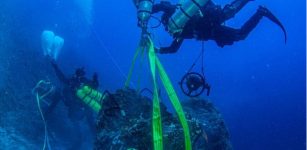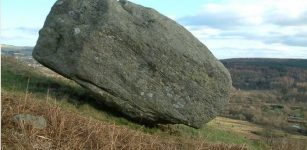Why Did Vikings Carry Decorative Swords That Were Useless In Combat?
Ellen Lloyd - AncientPages.com - Scientists have discovered that Vikings occasionally carried useless decorative swords that could not be used as real weapons.
It seems odd that a Viking warrior would bother to go around with a decorative sword if it could not be used in combat. Were the Vikings vain, or was there another reason why decorative swords became popular?
Left: Viking warrior - Adobe Stock - Ana - Right: Viking swords displayed at Hedeby Viking Museum - Credit: Wikipedia - Image compiled by AncientPages.com
As Ancient Pages wrote earlier, to ancient Vikings a sword was much more than just a weapon. Since swords were difficult to make, they were rare and expensive, and as such, they were not so common and used by kings and Vikings of high rank and class.
Norse Weaponry And Armor
Our information about Norse weaponry and armor during the Viking Age primarily comes from archaeological findings in grave sites and depictions carved on stones. The Sagas and legal texts from later periods also provide insights into how the Norsemen armed themselves for combat.
During the time of the Gulating laws in Norway, Denmark, and Sweden, every able-bodied man needed to own weapons according to his status. In Norway, a sword or ax, spear, and shield were required, while in Sweden and Denmark, each man had to possess a sword, spear, shield, and iron helmet. Furthermore, some laws stipulated that a mail shirt or protective jerkin, a bow, and 24 arrows be provided for each bench seat on a ship or by the local chieftain.
As part of a coming-of-age ceremony, a Norse freeman would receive an armring from his lord, pledging loyalty and service, including the obligation to participate in wars or raids when summoned. Bearing an armring was also a status symbol, and some lords would reward their new subjects with weapons upon swearing oaths.
The use of weapons was an integral part of Norse culture, and from an early age, young boys were trained in their use as part of everyday life. This was a common practice among the different Norse clans.
Vikings believed a man and his sword were bound together. The sword gave power to the warrior, but the warrior’s strength could also be transferred to the sword.
This is also why we often encounter remarkable stories of magical swords in many Norse myths and legends. The Norse people were convinced that some swords were just as powerful as mysterious.
Tyrfying and Gram are two famous magical swords in Norse mythology.
The Norse legend of hero Sigmund and the magical sword in the Branstock tree mentioned in the Sigurdsaga, which is part of the Volsunga Saga (Völsunga Saga), show why swords were believed to have such unusual properties.
Some Viking artifacts remain an unsolved mystery even today. One such example is the Ulfberht Sword. It’s an ancient artifact far ahead of its time, and we do not know whose name is inscribed on this enigmatic ancient sword.
Not long ago, scientists discovered the importance of Vikings’ decorative swords.
Three Viking Age swords were examined. Credit: National Museum of Denmark
A neutron diffraction study conducted on three Viking swords from the National Museum of Denmark revealed that these weapons were created using pattern-welding, a technique in which thin strips of different kinds of iron and steel are welded together and then folded, twisted, and forged in various ways to produce decorative patterns on the resulting surfaces.
All three swords date to the ninth or 10th century A.D. and come from Central Jutland in what is now Denmark.
According to Anna Fedrigo, a materials scientist at the Technical University of Denmark, this was the first study that allowed researchers to virtually 'slice' Viking swords, showing how different materials have been combined.
Scientists say Viking swords covered with beautiful decorations became symbols of power and status. They were rarely used because they were never designed for combat. As the role of swords changed in Viking society, these ‘weapons’ simply became decorative clothing accessories.
So, yes, one can say that Vikings were vain, and showing one's importance in society was common. Vikings also used strong colors as a symbol of status and wealth.
First version of this article was published on December 19, 2017
Written by Ellen Lloyd – AncientPages.com
Copyright © AncientPages.com All rights reserved. This material may not be published, broadcast, rewritten or redistributed in whole or part without the express written permission of AncientPages.com
Expand for referencesJournal of Archaeological Science: Reports - Volume 12, April 2017, Pages 425-436
More From Ancient Pages
-
 Two 19th Dynasty Royal Statues Unearthed At Ancient Site Of Heliopolis, Cairo, Egypt
Archaeology | Mar 11, 2017
Two 19th Dynasty Royal Statues Unearthed At Ancient Site Of Heliopolis, Cairo, Egypt
Archaeology | Mar 11, 2017 -
 Rare Ulfberht Viking Sword Discovered In Suldal, Norway
Archaeology | May 31, 2024
Rare Ulfberht Viking Sword Discovered In Suldal, Norway
Archaeology | May 31, 2024 -
 Beautiful Zeugma-Like Mosaics Unearthed In Sinop Province, Northern Turkey
Archaeology | Oct 17, 2020
Beautiful Zeugma-Like Mosaics Unearthed In Sinop Province, Northern Turkey
Archaeology | Oct 17, 2020 -
 Mysterious Ancient Falicon Pyramid And Its Complex Obscure History
Featured Stories | Nov 28, 2018
Mysterious Ancient Falicon Pyramid And Its Complex Obscure History
Featured Stories | Nov 28, 2018 -
 The Lycurgus Cup: Fascinating Artifact That Reveals Prehistoric Knowledge Of Nanotechnology
Ancient Technology | Aug 2, 2018
The Lycurgus Cup: Fascinating Artifact That Reveals Prehistoric Knowledge Of Nanotechnology
Ancient Technology | Aug 2, 2018 -
 Paleolithic Humans May Have Understood The Properties Of Rocks For Making Stone Tools
Archaeology | Dec 2, 2023
Paleolithic Humans May Have Understood The Properties Of Rocks For Making Stone Tools
Archaeology | Dec 2, 2023 -
 Earliest Ochre Crayon Used By Our Ancestors 10,000 Years Ago Found In Yorkshire, Northern England
Archaeology | Jan 29, 2018
Earliest Ochre Crayon Used By Our Ancestors 10,000 Years Ago Found In Yorkshire, Northern England
Archaeology | Jan 29, 2018 -
 Massive Head Of Hercules Pulled From The Antikythera Shipwreck
Archaeology | Jun 23, 2022
Massive Head Of Hercules Pulled From The Antikythera Shipwreck
Archaeology | Jun 23, 2022 -
 8200-Year-Old ‘Viste Individual’ – DNA Analysis May Shed Light On Early Migration To Norway
Archaeology | Dec 6, 2015
8200-Year-Old ‘Viste Individual’ – DNA Analysis May Shed Light On Early Migration To Norway
Archaeology | Dec 6, 2015 -
 Ancient City Of Laodicea With One Of ‘Seven Churches Of Asia’ Founded By The King Antiochus II
Featured Stories | Jul 26, 2021
Ancient City Of Laodicea With One Of ‘Seven Churches Of Asia’ Founded By The King Antiochus II
Featured Stories | Jul 26, 2021 -
 Anaximander Of Miletus: Father Of Cosmology, Pre-Socratic Greek Philosopher Who Discovered Equinox, Solstices And Gnomon
Featured Stories | Mar 7, 2019
Anaximander Of Miletus: Father Of Cosmology, Pre-Socratic Greek Philosopher Who Discovered Equinox, Solstices And Gnomon
Featured Stories | Mar 7, 2019 -
 Qeros: Study Of Drinking Vessels Provide New Clues To Long Traditions Of Andean People
Archaeology | Jul 27, 2020
Qeros: Study Of Drinking Vessels Provide New Clues To Long Traditions Of Andean People
Archaeology | Jul 27, 2020 -
 Neanderthals Used Amlash Caves In Iran’s Gilan Province As Shelters
Archaeology | Aug 19, 2020
Neanderthals Used Amlash Caves In Iran’s Gilan Province As Shelters
Archaeology | Aug 19, 2020 -
 Inchbrayock Stone: Pictish Samson Stone Carved With Biblical Symbols And Scenes
Artifacts | Jan 21, 2019
Inchbrayock Stone: Pictish Samson Stone Carved With Biblical Symbols And Scenes
Artifacts | Jan 21, 2019 -
 Hapi: Early Egyptian God Of The Nile And Bringer Of Fertility, Abundance And Life
Egyptian Mythology | Mar 20, 2019
Hapi: Early Egyptian God Of The Nile And Bringer Of Fertility, Abundance And Life
Egyptian Mythology | Mar 20, 2019 -
 Ancient Secrets Of Sacred Towers And Stone Circles In Colorado Where Spirits Of Native Americans Still Live
Civilizations | Mar 19, 2017
Ancient Secrets Of Sacred Towers And Stone Circles In Colorado Where Spirits Of Native Americans Still Live
Civilizations | Mar 19, 2017 -
 Mystery Of Egyptian Queen Hetepheres I’s Bracelets Solved!
Archaeology | Jun 2, 2023
Mystery Of Egyptian Queen Hetepheres I’s Bracelets Solved!
Archaeology | Jun 2, 2023 -
 Monumental Grave Of Ancient Greek Poet Aratus Located In Mersin- But It Cannot Be Opened
Archaeology | Jun 4, 2017
Monumental Grave Of Ancient Greek Poet Aratus Located In Mersin- But It Cannot Be Opened
Archaeology | Jun 4, 2017 -
 13,000-Year-Old Engraving May Depict First Paleolithic Social Group Of Humans
Archaeology | Dec 4, 2015
13,000-Year-Old Engraving May Depict First Paleolithic Social Group Of Humans
Archaeology | Dec 4, 2015 -
 The Use Of Surnames Started During The Middle Ages In England
Ancient History Facts | Feb 23, 2016
The Use Of Surnames Started During The Middle Ages In England
Ancient History Facts | Feb 23, 2016


